
Education in the Knowledge Society 24 (2023)

Relationship between the Use of ICT in Secondary Education Music Teaching and Teachers’ Beliefs
La relación entre el uso de las TIC en la docencia de la Música en educación secundaria y las creencias del profesorado
Pilar Colás-Bravoa, Guadalupe Hernández-Porterob*
a Departamento de Métodos y Diagnóstico en Educación, Universidad de Sevilla, España.
https://orcid.org/0000-0003-3000-075Xpcolas@us.es
b Departamento de Educación Artística, Universidad de Sevilla, España
https://orcid.org/0000-0003-4751-7704ghportero@us.es
ABSTRACT
The use of ICT in teaching has ostensibly increased over the last few years, especially due to distance teaching imposed during the pandemic. Our study aims to understand how Music teachers use ICT and how it relates to their beliefs regarding its pedagogical value for teaching and learning. We adopt a quantitative methodology based on a survey-type design first and an ex post facto design in the second stage. The results show limited use of ICT among secondary school Music teachers generally, and how its degree of use (high, medium, low) correlates with their beliefs regarding their pedagogical value, i.e., higher value leads to more frequent use. Therefore, ICT use should be promoted to reach broader acceptance and integration in Music teaching.
Keywords
Music education, ICT, secondary education, teachers’ training, teachers’ beliefs.
RESUMEN
El uso de las Tecnologías de la Información y la Comunicación (TIC) en la docencia se ha incrementado considerablemente en los últimos años, especialmente a consecuencia de la enseñanza virtual obligada por la pandemia. En nuestro estudio tratamos de conocer el uso que el profesorado de Música hace de las TIC y cómo se relaciona con las creencias que este profesorado tiene sobre su valor pedagógico tanto para la enseñanza como para el aprendizaje. Nos valemos de una metodología cuantitativa basada primero en un diseño tipo encuesta y en un segundo estadio un diseño ex post facto. Los resultados obtenidos desvelan un uso limitado de las TIC a nivel general por parte del profesorado de Música de educación secundaria y muestran cómo los distintos niveles de uso de las TIC —bajo, medio y alto— se relacionan con sus creencias sobre el valor pedagógico de estas tecnologías, siendo mayor la valoración positiva de las TIC cuanto mayor es el nivel de utilización. Por tanto, es necesario fomentar un mayor uso de las TIC para que pueda revertir en una actitud más abierta respecto a su integración en la docencia de la Música.
Palabras clave
educación musical, TIC, educación secundaria, formación del profesorado, creencias.
1. Introduction
The incorporation of Information and Communication Technologies (ICT) in Music Education has been the object of analysis and research in the last years. Ruthmann and Mantie (2017) edited a monograph on the use of Information and Communications Technology (ICT) in Music Teaching at the Primary and Secondary Education levels. In one of the chapters, Partti (2017) concludes that ICT integration in teacher training music curriculum is still low. A poor technological training may explain teachers’ lack of confidence and competences in ICT, which results in a lack of interest in incorporating ICT in teaching-learning processes. The author (Partti, 2017) concludes that it is necessary to broaden research on Music Education with ICT; but there are also few diagnoses on the specific situation of each country to have an overall picture available and direct future developments. In this sense, we have contributions such as those by Biasutti (2012), who analyzed ICT incorporation in Music Education in Italy, or Gall’s recent contribution (2017) on Technology in Music Education in England and the European context. In the case of Spain, we also have several contributions (Colás-Bravo & Hernández-Portero, 2014, 2017; Serrano, 2017; Aróstegui et al., 2021), even if there are not many studies dealing with this issue.
However, the situation of COVID 19 has hastened and forced the ICT use resources to teach the Music syllabus in Spain's Education system. In many cases, a passive musical education is taught, this being grounded on reproductive activities, justified due to the lack of resources or instruments offered by the educational authorities (Calderón-Garrido & Gustems-Carnicer, 2021). This application to the Musical Education syllabus seems to depend largely on the previous usage that teachers make of ICT resources on-hand (Pozo et al., 2022). However, research into the incidence of these practices on the teachers’ beliefs regarding their value in the sphere of Music teaching has not been forthcoming. With this in mind, our purpose is to inquire further into the usage levels of ICT in Music teaching in Secondary Education and its relationship with educational beliefs held by teachers on these.
2. Music teachers training in secondary education in Spain. Beliefs and practices with ICT
Music teacher training in Spain displays certain idiosyncrasies that clearly differentiate it from other teaching disciplines. Knowing the training they receive in ICT is pivotal in order to understand and analyze the educational uses they make of ICT in their classrooms. There are numerous studies that affirm (Burke et al., 2018; Englund et al., 2017; Ruthmann & Mantie, 2017; Valverde et al., 2021) that teacher training is a key factor for ICT integration in the school syllabus. In Spain, music teachers’ training presents a very peculiar situation, as multiple training channels are recognized (Colás-Bravo & Hernández-Portero, 2017). Such teachers receive an initial training and another one in service. In initial training, it is possible to access teaching career from several degrees: a) advanced degree issued by a music conservatory and b) university degree in Music History and Sciences. In the first case, education has a more technical orientation and, in the second, more historical. According to certain Spanish studies (Colás-Bravo & Hernández-Portero, 2014; 2017; Rodríguez-Quiles, 2017), both pedagogical and ICT training are very reduced in this initial training.
In-service training is based on several proposals from public and private offers aimed at ICT teachers’ training, which is always voluntary. Training diversification leads to differentiated teaching profiles, which has an effect on ICT integration in music education (Colás-Bravo & Hernández-Portero, 2014; 2017). As ICT education is a variable with a direct effect on the educational use of ICT, we focused our interest in disclosing the levels of use of ICT in music education. As numerous studies have stated (Cejas, et al., 2016; Ifinedo et al., 2020; Kopcha et al., 2014; Zhang et al., 2019) technological, pedagogical and educational knowledge is essential in classroom practice with ICT. In this line, Mishra and Koehler (2006) proposed the TPCK (Technological Pedagogical Content Knowledge) model as a key educational reference for ICT application in the classroom. From these references, these three types of knowledge converge in the educational praxis.
Numerous studies state that another factor that determines the ICT use, together with training, is the teachers’ belief about the pedagogical value of ICT (Alberola et al., 2021; Biesta, et al., 2015; Cronenberg, 2019; Kos, 2018; Shifflet & Weilbacher 2015; Teo & Zhou, 2016). Therefore, we focus our interest on knowing the relationship between the ICT use and the pedagogical beliefs associate to it.
Even if we have studies that provide details on ICT integration in the Spanish educational system (Area et al., 2014; Colás-Bravo et al., 2018; Paredes, 2013), there are few scientific references on ICT use levels in Music Teaching in Secondary Education in Spain, an aspect that is going to be the object of this study. On the other hand, there are also few studies that associate the uses of ICT with teachers’ pedagogical beliefs. Taking the TPCK (Technological Pedagogical Content Knowledge) model as starting point, we can infer that the use of ICT is linked to technological and pedagogical (besides educational) knowledge. The levels of technological and pedagogical levels are expressed in educational praxis. That is why we intend to investigate the pedagogical beliefs and ideas linked to the levels of use of ICT in music education.
In this line, there are studies available (Biesta et al., 2015; Kos 2018; López & La Malfa, 2020; Niederhauser & Stoddart, 2001; Shifflet & Weilbacher, 2015; Teo & Zhou, 2016) that suggest that the use of ICT in discipline teaching, such as Music, depends on both, the teachers’ beliefs, and knowledge. With regard to our case, we have included the variable “practices” as an explanatory factor in the beliefs held, as in the previous studies, its relationship was noted (De Pablos et al., 2015).
That is why this study considered doing research on the use levels of ICT in Music Education and identifying music teachers’ conceptions and beliefs on the educational value of ICT linked to their levels of use in the classroom.
3. Method
This study is part of the research line ICT integration in the Spanish Educational System carried out by the Research Group “Research, Evaluation and Technology” (GIETE) of the University of Seville (Spain), which has been financially supported by the Ministry of Education and Culture and of the European Commission, through R&D announcements. This line of research has produced publications that collect results on variables that affect the integration of ICT in schools of the Spanish Educational System (Colás-Bravo et al., 2018; Colás-Bravo & Hernández-Portero, 2014; 2017). This specific study focuses on the levels of didactic ICT use in the teaching of Music in Secondary Education and its relationship with music teachers’ conceptions and beliefs. In short, we intend to evaluate scientifically how educational practices are linked to certain pedagogical conceptions and beliefs.
3.1. Objectives
The specific scientific aims set forth are to:
A)Identify usage levels of ICT in Secondary Education used by Music teachers in Andalusia (Spain).
B)Determine the relationship between didactic uses of ICT and the educational value the Music teachers bestow upon this.
C)Verify which beliefs held on the students’ learning are associated with the different levels of ICT use in the teaching of Music in Secondary Education.
In essence, the aim is to ascertain whether the levels of ICT use in the teaching of Music in Secondary Education are linked to the beliefs held by teachers regarding their pedagogical value in the classroom.
We try to contrast two research hypotheses:
Hypothesis 1: The levels of use of ICT in music education are related to the value that teachers grant to ICT in their teaching.
Hypothesis 2: The levels of use of ICT in music education relate significantly to the beliefs about Secondary Education students’ learning.
3.2. Procedure and participants
In this research work, we apply a descriptive methodology, a survey-type design first, and an ex post facto design on a second stage.
The survey method provides information on the variables object of this study: levels of use of ICT in music education and teachers’ beliefs on the value of ICT for music teaching and learning.
Later, we established three groups that represent three levels of use of ICT; Group 1: low level, Group 2: medium level and Group 3: high level. This methodology allows us to respond to the objectives of the study with regard to the relation of the independent variable, the level of use of ICT, to teachers’ beliefs about the influence of ICT in the music teaching and learning process.
The study population and sample are made up of Secondary Education music teachers who teach in High Schools in Andalusia (Spain). From the overall population, 153 answers were obtained from teachers of both genders, who agreed to answer the survey voluntarily. Sample composition regarding gender, age and teachers’ experience ended up being quite balanced, with 47% of men and 53% of women, with an age between 25 and 62 years old and a teaching experience between 3 and 33 years. They all had Spanish origin and nationality.
3.3. Instrumentation
To collect the data, we prepared a questionnaire ad hoc that included items three dimensions: a) levels of use of ICT in music education, b) teachers’ beliefs on the value of ICT for their teaching and c) beliefs on the value of ICT for students learning.
Each one of these dimensions is specified in an itemized list whose responses are registered in two Likert-type scales that include 5 answer options, where a scoring 1 means total disagreement up to 5, that means total agreement.
Below, the items corresponding to the questionnaire’s dimension are listed for a) usage made by teachers of ICT in the classroom in Secondary Education in music teaching.
•Usage of ITC to attain targets.
•Usage of ITC to make Music more appealing.
•Usage of ITC to improve learning.
•Usage of ITC so that the student can build their own learning plan.
•Usage of ITC to foster collaborative work between students.
•Usage of ITC to explain syllabus items and appraise.
•Usage of ITC as resource for reinforcement and expansion.
•Usage of ITC so that students create knowledge.
For the identification of usage levels, an analysis of clusters was performed on the results obtained. These results provided three clusters. The first cluster contains subjects that are positioned with low values in the responses to the scale’s items. A second cluster brings together subjects with average scores in the items, and a third group, characterised by high scores.
Items corresponding to the dimension b) are recorded in Table 1 and Table 2. The dimension c) of the questionnaire is specified in the items listed in Table 3.
Table 1. ANOVA Results. The DV correspond to beliefs on the value of ICT for music education. The IV is the level of use of ICT in the classroom.
ANOVA |
|||||
|
Square addition |
gl |
Square average |
F |
Sig. |
Improve my teaching practice |
11.626 |
2 |
5.813 |
6.627 |
.003 |
Boost didactic-methodological development |
11.467 |
2 |
5.734 |
8.185 |
.001 |
Hinder methodological development |
3.281 |
2 |
1.641 |
3.397 |
.044 |
Are a waste of time |
6.615 |
2 |
3.307 |
3.754 |
.032 |
Time devoted to ICT is worth it |
2.962 |
2 |
1.481 |
1.538 |
.227 |
Improve students’ learning |
13.599 |
2 |
6.799 |
11.029 |
.000 |
Higher motivation and interest for learning |
8.503 |
2 |
4.252 |
6.309 |
.004 |
Distract from the most important |
8.608 |
2 |
4.304 |
7.989 |
.001 |
Table 2. Results of the application of Kruskal Wallis test. Dependent variable: music teachers’ beliefs on the educational value of ICT. Independent variable: levels of use of ICT in the classroom.
|
Chi-square |
gl |
Asymptotic sig. |
Improve my teaching practice |
10.611 |
2 |
0.005 |
Boost didactic-methodological development |
13.098 |
2 |
0.001 |
Hinder methodological development |
8.089 |
2 |
0.018 |
Are a waste of time |
7.541 |
2 |
0.023 |
Time devoted to ICT is worth it |
4.435 |
2 |
0.109 |
Improve students’ learning |
15.48 |
2 |
0 |
Higher motivation and interest for learning |
10.353 |
2 |
0.006 |
Distract from the most important |
12.598 |
2 |
0.002 |
Note. a. Krustal Wallis test; b. Grouping variable: ICT use level.
Table 3. Results of the application of Kruskal Wallis test to DV.: Evaluation of music teachers on students’ learning with ICT. IV: level of use of ICT in the classroom.
|
Chi-square |
gl |
Asymptotic sig. |
The use of ICT has an effect in students’ learning |
11.104 |
2 |
0.004 |
ICT use enhances knowledge acquisition |
10.894 |
2 |
0.004 |
Facilitate the learning process |
9.935 |
2 |
0.007 |
Retard the learning process |
4.286 |
2 |
0.117 |
Improve students’ attitude towards Music |
14.807 |
2 |
0.001 |
Foster collaboration attitudes among students |
12.109 |
2 |
0.002 |
Note. a. Kruskal Wallis test; b. Grouping variable: ICT use level
Content validation is made through experts’ assessment (2). The internal reliability or consistency of these scales is estimated through Cronbach’s α. A Cronbach's α of 0.915 is obtained in the first case and 0.925 in the second scale; this means that reliability is very good.
3.4. Data sources and data analyses
Data were collected online, and we obtained information from teachers who wanted to participate and collaborate in this research work. We analyzed data using different statistic tests through the SPSS V.23 program. We applied descriptive statistics and statistical comparison of the null hypothesis. The research hypotheses were confirmed through ANOVA statistics and the Kruskal Wallis test. The Independent Variable (IV) registered the three levels of use of ICT made by teachers in music education. The Dependent Variables (DV) included items referred to teachers’ beliefs on the ICT utility in music teaching and students’ learning.
4. Results
The data presented in this section intend to give an answer to the research questions posed.
Regarding the levels of use of ICT by music teachers, Figure 1 expresses the following results.
Figure 1. Percentage of teachers who make use of ICT in different levels (low use, medium use and high use).
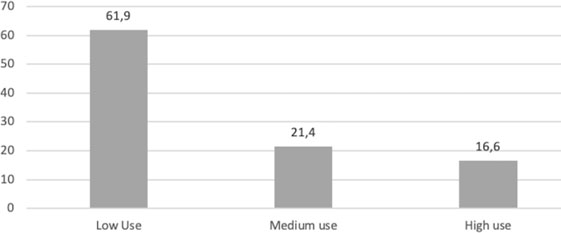
This figure shows us that more than 50% of music teachers make a low use of ICT. A medium use represents 21.4% of teachers and an intensive use represents 16% of the total of music teachers.
4.1. Incidence of level of use of ICT in teachers’ beliefs on their value for music teaching
The Variance Analysis test of an ANOVA Factor permits to confirm if there are differences between groups with a different level of use of ICT in the classroom. The results obtained are exposed in Table 1.
The results show us that the null hypothesis has been rejected, as the p value obtained is p ≤ 0.05, in all the items referred to the value of ICT in music education and therefore the alternative hypothesis that says that the levels of use of ICT mark significant differences in the value granted by music teachers has been accepted. There is just one variable, the “Time devoted to ICT is worth it”, in which the null hypothesis has been accepted, as the p value is 0.227, p ≥ 0,05. Therefore, we can interpret that the level of use of ICT in the classroom bears significant relation to the beliefs on the value of ICT for music education. In this sense, upon observation of the averages obtained by the groups, we confirm that, the higher the level of use, the higher the positive assessment of ICT for music education. In short, the results obtained show us that all the items, except one, are significant p ≤ 0.05; therefore, the null hypothesis of no difference between groups has been rejected and the alternative la hypothesis has been accepted.
As an example, we show the relationship of these variables in two of the items (see Figures 2 and 3).
Figure 2. Relationship between the uses of ICT (low use, medium use, and high use) and music teachers’ beliefs with regard to their improvement of teaching practice.
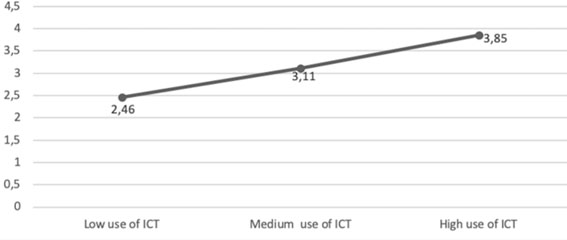
Figure 3. Relationship between the uses of ICT (low use, medium use and high use) and teachers’ beliefs about its benefits for didactic–methodological development.
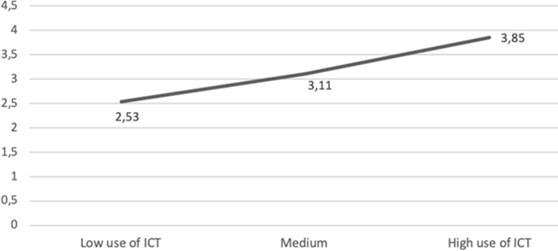
However, the behavior is inverse when items are referred to negative aspects, as illustrate in Figures 4 and 5.
Figure 4. Relationship between the uses of ICT (low use, medium use, and high use) and music teachers’ beliefs about the disadvantages of ICT for methodological development.
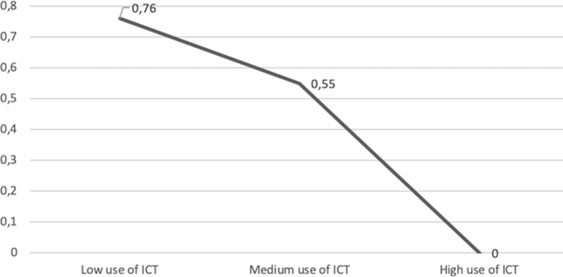
Figure 5. Relationship between the uses of ICT (low use, medium use, and high use) and music teachers’ beliefs about the fact that ICT are a waste of time.
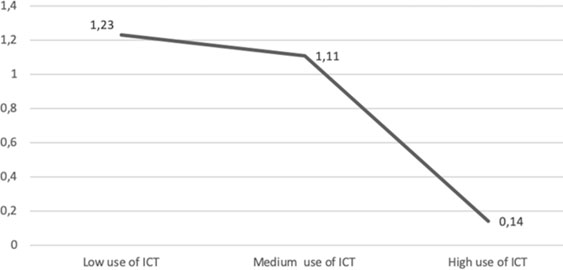
As the variables are registered in an ordinal scale, we confirm the previous results with the Kruskal-Wallis Test. The results obtained are showed in Table 2. In this case, we obtain results converging with the previous test applied (ANOVA), rejecting the null H in all cases, except in the variable “Time devoted to ICT is worth it”.
4.2. Incidence of level of use of ICT in music learning
In this paragraph we show the results that allow us to corroborate the initial hypothesis of checking if there are significant differences among the three established groups regarding the beliefs on learning that facilitate ICT. To that end, we apply the Kruskal Wallis test. The results obtained can be seen in Table 3.
These results confirm the alternative hypothesis in all items except in “retards the learning process”, obtaining a “p” value of 0,117 (p ≥ 0.05). In the rest of items, the null hypothesis H=0 was rejected, as values less than p ≤ 0.05 are obtained. Therefore, we can conclude that there are significant differences among the three groups of music teachers regarding the perception of ICT value in students’ learning. The relation between ICT use and an improvement on students’ attitude towards learning converge with results of other research works (Biasutti & Concina, 2021; Crawford, 2017; Stowell & Dixon, 2014).
Therefore, considering these results, we can point out that the level of use of ICT by teachers influences their educational perception regarding the value of ICT in students’ teaching and learning. This information confirms other scientific results (Eyles, 2018; Stowell & Dixon, 2014), as teaching praxis is linked to teachers’ conceptions and perceptions.
To summarize the results obtained we prepared Figures 6 and 7, which reflect the measures obtained in items related to teachers’ beliefs on the incidence of ICT in their teaching and students’ learning, respectively. They show how the highest average corresponds to teachers who make a more intensive use of ICT and the lowest to the group of teachers who make a less intensive use of ICT.
Figure 6. Average scoring of each group of teachers in the variables of beliefs on ICT in teaching.
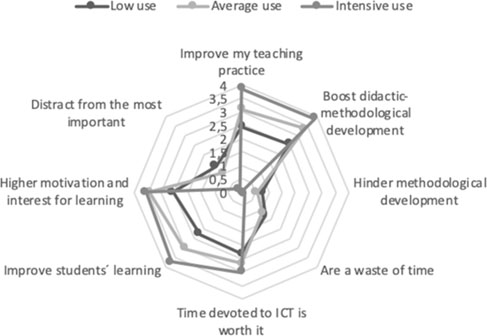
Figure 7. Average scoring of each group of teachers in the variables of beliefs on ICT in learning.
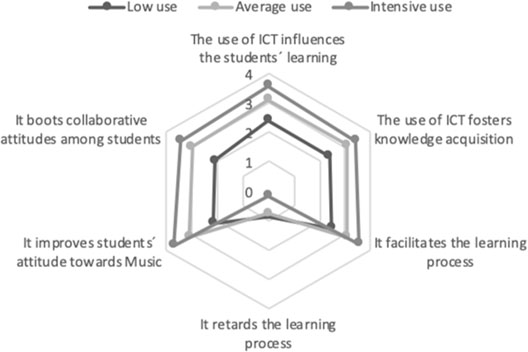
In view of these results, we are considering analyzing which beliefs on music education are associated to the different levels of use of ICT.
The results obtained are reflected in Figure 6.
Upon reading Figure 6, it shows us profiles of beliefs of music teachers according to the level of use of ICT. Thus, teachers who make an intensive use of ICT in their classes grant high valuation levels to the idea that they improve the teaching practice and enhance students’ learning, besides favoring the didactic-methodological development and students’ motivation and interest. However, these beliefs show up in the group who makes a less intensive use of ICT. And more negative beliefs prevail than in the group that makes a more intensive use, such as that they are distracting and retard methodological development, with the consequent waste of time. The average use group is between both groups in these valuations.
We have shown below in Figure 7 how the level of use of ICT influences teachers’ beliefs on learning aspects.
In this figure we can observe a correspondence between levels of use and conceptions on the value of ICT for learning. The group with a higher level of use of ICT obtained higher average values regarding the use of ICT in students’ learning, fostered knowledge acquisition, boosted collaborative attitudes among students and attitude towards Music, besides facilitating the learning process. These evaluations are reversed in the variable that states that ICT hinder the learning process.
Therefore, the results obtained in this research work leads us to conclude that the use of ICT influences teachers’ conceptions and beliefs about their integration in music education. Teachers who make a more intensive use of ICT have a more positive conception of their value in music teaching and learning than those who do not use them often.
In short, a high percentage of music teachers do not use ICT very often when teaching. They have identified three levels of use: low, medium, and high. These levels are related to pedagogical beliefs on ICT value, both for teaching and for students’ learning. They have detected significant differences between groups regarding their conceptions about these aspects. The highest levels of ICT use by music teachers are linked to higher valuations regarding the belief that ICT foster their teaching practice and the methodological didactic development; and also, that ICT benefit students, improving learning processes, a positive attitude towards Music and students’ collaboration. Teachers who use ICT less often have more negative conceptions of ICT regarding their teaching and learning potential.
5. Discussion and conclusions
On the basis of the results obtained and taking as a reference the objectives marked in this study, specifically insofar as aim A) is concerned: identifying usage levels of ICTs in secondary education used by Music teachers in Andalusia (Spain), we can conclude that Music Education teachers of Secondary Education in southern Spain make a heterogeneous teaching use of ICT that shall have a certain impact on their integration in the class. More than 50% of such teachers rarely use ICT and only 16% use ICT intensively. Therefore, we can see that the use of ICT is not extensive yet in music teaching. However, we understand that this information is dynamic and diverse factors, amongst others the digitization of society, may foster increasingly more extensive use of digital tools on the part of Secondary Education teachers as part of the Music syllabus, alongside continually enhanced development of digital skills in teachers (Camlin & Lisboa, 2021). Plus, these practices mean a shift in the beliefs held by teachers of the educational value of ICT is foreseeable.
With regard to the hypothesis of the relation between ICT uses and conceptions about their value for teaching and learning, we conclude that there is a significant difference between the established groups based on their levels of ICT use with respect to music teachers’ beliefs on the educational use of ICT, the higher the levels of use of ICT, the higher the positive valuation. These results coincide with the contributions of other related studies (Ertmer, Ottenbreit & Tondeur, 2015; Eyles, 2018; Nelson & Hawk, 2020; Shifflet & Weilbacher, 2015; Teo & Zhou, 2016). Therefore, it can be concluded that, responding to the second of our aims, there is a relationship between the educational usage of ICT and the instructional value the Music teachers bestow upon this.
Another significant difference comes of their beliefs regarding ICT incidence in students’ learning; the certainty of the value of ICT for students’ learning in the groups of teachers who make a more intensive use of ICT is also higher. These results also coincide specifically with other research works focused on the motivational dimension for learning (Aróstegui et al., 2021; Crawford, 2017; Cronenberg, 2019; Hedden, 2020). These studies concluded that the use of technology in Music Education fosters stimulating and motivating teaching and learning situations. Other contributions, such as those of Stowell and Dixon (2014), Crawford (2017), Ruthman and Mantie (2017) or Biasutti and Concina (2021), corroborate that ICT enhance creativity, facilitate learning, and boost independent exploration and learning. In this way, the results obtained in this research work provide a response to the study’s third aim, duly verifying the existence of beliefs on the students’ learning that are linked to the different usage levels of ICT in the teaching of Music in Secondary Education.
Therefore, the levels of use of ICT in music education are linked to differenced profiles regarding teachers’ valuation of aspects related to music teaching and learning. The highest levels of use are linked to higher valuations in positive aspects, whereas the lowest levels get a lower scoring in the most positive aspects and higher in the negative aspects.
Finally, considering that this use of ICT in teachers’ training depends on their knowledge and, therefore, their training in this field, an aspect that has also been endorsed by other research works on this subject (Colás-Bravo & Hernández-Portero, 2017; Eyles, 2018; Niedderhauser & Stoddart, 2001; Valverde et al., 2021), we concluded that teachers’ initial training is a key factor for ICT integration in the school syllabus (Burke et al., 2018; Englund et al., 2017; Ruthmann & Mantie, 2017; Somekh, 2008). The still not extensive use of ICT in Music teaching could be fostered reinforcing teachers’ initial and continuing education training. Educational practices using ICT are, as we have proven in this research work, a relevant factor for the transformation of beliefs held by teachers.
The results of the study are limited by the selection of the subjects of the sample, which is not probabilistic and, therefore, the data obtained cannot be generalized to a larger population. The cultural context can also be regarded as a limitation, and the results obtained could be different in other cultural contexts. The specificity typical of music teachers’ education also limits the results to this population and cannot be transferred to teachers from other subjects and fields.
5.1. Educational implications and further developments
The knowledge of ICT integration in Music Education has not had many contributions. However, it is relevant to propose enhancement plans in teachers’ training. In this research work, we have detected a poor use of ICT in music teaching and learning processes, which leads to consider the need of boosting teachers’ training in ICT. In this sense the European Union and member states aim to foster digital citizenship through different strategic lines of action, such as the “Digital Competence Framework for Educators” (DIGCOMPEDU), published in 2020, or the “Action Plan for Digital Education” (2021-2027) that offers references to guide teacher training. In Spain we have the “Reference Framework for teaching digital competence” of the Ministry of Education and Professional Training (published in 2020) that guide teachers’ training for ICT integration in their professional skills as teachers.
The results of this study are valuable to help to offer training programs to Music teachers that help to develop the pedagogical use of ICT, as well as the contents and knowledge necessary to make an effective use of technologies to develop citizens’ digital skills.
On the other hand, the study provides data for understanding the relation between the ICT uses and the teachers’ beliefs on their educational value for music teaching and learning. For this reason, it is possible to think that the increase in the use of ICT, to which teachers have been forced because of the pandemic, will lead to a modulation of teachers' beliefs in relation to their pedagogical value for the teaching of music. It would be useful to contrast this fact with further research.
There are several educational implications of the findings of the current study. First, we find that the use of ICT is related to the beliefs of teachers about their educational value. Therefore, it would be useful to establish exchanges of experiences with teachers who make greater use of ICT to know the benefits they provide for teaching practice and student learning. Secondly, the study provides data on the scarce use of ICT by Music teachers in Andalusia. This could also be promoted with the proposals for collaborative exchange between teachers and even with the orientation towards the didactic uses of ICT in teacher training programs to show its usefulness for teaching and learning music.
Finally, the research approach adopted in this study based on a quantitative methodology could be completed including research designs with a qualitative approach, after the effects of the covid pandemic in the teaching methods of teachers. This perspective would allow to deepen and delve into numerous aspects on the incidence of forced use of ICT in Music teachers’ pedagogical beliefs and conceptions. In addition, ethnographic designs, based on classroom observations, might support, in praxis, data indirectly obtained through questionnaires. The narrative methodology could also illustrate Music teachers’ educational transformation processes, because of these new ways of teaching.
The extension to other cultural contexts and professional teaching specialization areas may also be object of interest for future research works.
References
Alberola-Mulet, I., Iglesias-Martínez, M. J., & Lozano-Cabezas, I. (2021). Teachers’ Beliefs about the Role of Digital Educational Resources in Educational Practice: A Qualitative Study. Education Sciences, 11(239). https://doi.org/10.3390/educsci11050239
Area, M., Alonso, C., Correa, J. M., del Moral, M. E., De Pablos, J., Paredes, J., Peirats, J., Sanabria, A. L., San Martín, A., & Valverde, J. (2014). Las políticas educativas TIC en España después del Programa Escuela 2.0: las tendencias que emergen. RELATEC Revista Latinoamericana de Tecnología Educativa, 13(2), 11–33. https://doi.org/10.17398/1695-288X.13.2.11
Aróstegui, J. L., Rusinek, G., & Fernández-Jiménez, A. (2021). Escuelas musicales. Buenas prácticas docentes en centros de Primaria y Secundaria que educan a través de la música. Octaedro.
Biasutti, M. (2012). ICT in music education in Italy: Contexts, potentialities & perspectives. In M. Gall, A. De Vugt, & G. Sammer (Eds.), European Perspectives on Music Education: New media in the classroom (pp. 135–148). Helbling.
Biasutti, M., & Concina, E. (2021). Online composition: Strategies and processes during collaborative electroacoustic composition. British Journal of Music Education, 38(1), 58–73. https://doi.org/10.1017/S0265051720000157
Biesta, G., M., Priestley, & Robinson, S. (2015). The role of beliefs in teacher agency. Teachers and Teaching: Theory and practices, 21(6), 624–640. https://doi.org/10.1080/13540602.2015.1044325
Burke, P. F., Schuck, S., Aubusson, P., Kearney, M., & Frischknecht, B. (2018). Exploring teacher pedagogy, stages of concern and accessibility as determinants of technology adoption. Technology, Pedagogy and Education, 27(2), 149–163. https://doi.org/10.1080/1475939X.2017.1387602
Calderón-Garrido, D., & Gustems-Carnicer, J. (2021). Adaptations of music education in primary and secondary school due to COVID-19: The experience in Spain. Music Education Research, 23(2), 139–150. https://doi.org/10.1080/14613808.2021.1902488
Camlin, D., & Lisboa, T. (2021). The digital ‘turn’ in music education. Music Education Research, 23(2), 129–138. https://doi.org/10.1080/14613808.2021.1908792
Cejas, R., Navío, A., & Barroso, J. (2016). Las competencias del profesorado universitario desde el modelo TPACK (Conocimiento Tecnológico y Pedagógico del Contenido). Píxel-Bit. Revista de Medios y Educación, 49, 105–119. https://doi.org/10.12795/pixelbit.2016.i49.07
Colás-Bravo, P., De Pablos, J., & Ballesta, F. J. (2018). Incidencia de las TIC en la enseñanza en el sistema educativo español: una revisión de la investigación. RED: Revista de Educación a Distancia, 18(56), 1–23. https://doi.org/10.6018/red/56/2
Colás-Bravo, P., & Hernández-Portero, G. (2014). Incidencia de la formación del profesorado en sus creencias sobre el valor de las TIC en la enseñanza de la Música. Educatio Siglo XXI, 32(3), 51–74. https://doi.org/10.6018/j/210981
Colás-Bravo, P., & Hernández-Portero, G. (2017). Itinerarios formativos del profesorado de Música: sus percepciones sobre el valor didáctico de las TIC. Revista Fuentes, 19(1), 39–56.
Crawford, R. (2017). Rethinking teaching and learning pedagogy for education in the twenty-first century: blended learning in music education. Music Education Research, 19(2), 195–213. https://doi.org/10.1080/14613808.2016.1202223
Cronenberg, S. (2019). Teaching general music to young adolescents: Findings from a survey of music teacher perspectives. International Journal of Music Education, 37(1), 43–58. https://doi.org/10.1177/0255761418794728
De Pablos, J., Colás P., González, T., & Conde, J. (2015). El Programa Escuela TIC 2.0 y sus efectos, según el profesorado. In J. De Pablos (Ed.), Los centros educativos ante el desafío de las tecnologías digitales (pp. 85–119). La Muralla.
Englund, C., Olofsson, A., & Price, L. (2017). Teaching with technology in higher education: understanding conceptual change and development in practice. Higher Education Research and Development, 36(1) 73–87. https://doi.org/10.1080/07294360.2016.1171300
Ertmer, P. A., Ottenbreit-Leftwich, A., & Tondeur, J. (2015). Teacher beliefs and uses of technology to support 21st century teaching and learning. In H. R. Fives & M. Gill (Eds), International handbook of research on teacher beliefs (pp. 403–418). Routledge, Taylor & Francis.
Eyles, A. (2018). Teachers’ perspectives about implementing ICT in Music Education. Australian Journal of Teacher Education, 43(5), 110–131. https://doi.org/10.14221/ajte.2018v43n5.8
Gall, M. (2017). Technology in Music Education in England and Across Europe. In A. Ruthmann & R. Mantie (Eds.), The Oxford Handbook of Technology and Music Education Oxford University Press. https://doi.org/10.1093/oxfordhb/9780199372133.013.2
Hedden, D. G. (2020). Lessons from Lithuania: Teacher beliefs and behaviors in teaching young children to sing. International Journal of Music Education, 38(4), 593–612. https://doi.org/10.1177/0255761419888015
Ifinedo, E., Rikala, J., & Hämäläinen, T. (2020). Factors affecting Nigerian teacher educators’ technology integration: Considering characteristics, knowledge constructs, ICT practices and beliefs. Computers & Education, 146, 103760. https://doi.org/10.1016/j.compedu.2019.103760
Kopcha, T., Ottenbreit, A., Jung, J., & Baser, D. (2014). Examining the TPACK framework through the convergent and discriminant validity of two measures. Computers & Education, 78, 87–96. https://doi.org/10.1016/j.compedu.2014.05.003
Kos, R. (2018). Becoming music teachers: preservice music teachers' early beliefs about music teaching and learning. Music Education Research, 20(5), 560–572. https://doi.org/10.1080/14613808.2018.1484436
López, M. C., & La Malfa, S. (2020). Perceptions of Compulsory Education Teachers About Cultural Diversity: A Study in the City of Messina. Journal of New Approaches in Educational Research, 9(1), 28–42. https://doi.org/10.7821/naer.2020.1.447
Mishra, P., & Koehler, M. (2006). Technological pedagogical content knowledge: a framework for teacher knowledge. Teachers College Records, 108(6), 1017–1054. https://doi.org/10.1111/j.1467-9620.2006.00684.x
Nelson, M. J., & Hawk, N. A. (2020). The impact of field experiences on prospective preservice teachers' technology integration beliefs and intentions. Teaching and Teacher Education, 89, 103006. https://doi.org/10.1016/j.tate.2019.103006
Niederhauser, D. S. & Stoddart, T. (2001): Teachers’ instructional perspectives and use of educational software. Teaching and Teacher Education, 17(1), 15–31. https://doi.org/10.1016/S0742-051X(00)00036-6
Paredes, J. (2013). Políticas educativas públicas sobre TIC en España: tres décadas donde los docentes universitarios influyeron en el cambio educativo. Revista Fuentes, 13, 45–78.
Partti, H. (2017). Building a broad view of technology in music teacher education. In A. Ruthmann & R. Mantie (Eds.), The Oxford Handbook of Technology and Music Education (pp. 123–128). Oxford University Press. https://doi.org/10.1093/oxfordhb/9780199372133.013.10
Pozo, J. I., Pérez-Echeverría, M. P., Casas-Mas, A., López-Íñiguez, G., & Cabellos, B. Méndes, E. (2022). Teaching and learning musical instruments through ICT: The impact of the COVID-19 pandemic lockdown. Heliyon, 8(1), e08761. https://doi.org/10.1016/j.heliyon.2022.e08761
Rodríguez-Quiles, J. (2017). Music Teacher Training: A precarious area within the Spanish University. British Journal of Music Education, 34(1), 81–94. https://doi.org/10.1017/S026505171600036X
Ruthmann, S. A., & Mantie, R. (2017). The Oxford Handbook on Technology in Music Education. Oxford University Press. https://doi.org/10.1093/oxfordhb/9780199372133.001.0001
Serrano, R. M. (2017). Tecnología y educación musical obligatoria en España: referentes para la implementación de buenas prácticas. Revista Electrónica Complutense de Investigación en Educación Musical, 14, 153–169. https://doi.org/10.5209/RECIEM.54848
Shifflet, R., & Weilbacher, G. (2015). Teacher Beliefs and Their Influence on Technology Use: A Case Study. Contemporary Issues in Technology and Teacher Education, 15(3), 368–394.
Somekh, B. (2008). Factors affecting teachers’ pedagogical adoption of ICT. In J. Voogt & G. Knezek (Eds.), International Handbook of Information Technology in Primary and Secondary Education (pp. 449–460). Springer. https://doi.org/10.1007/978-0-387-73315-9_27
Stowell, D., & Dixon, S. (2014). Integration of informal music technologies in secondary school music lessons. British Journal of Music Education, 31(1), 19–39. https://doi.org/10.1017/S026505171300020X
Teo, T., & Zhou, M. (2016). The influence in teacher’s concepcions of teaching and learning on their technology acceptance. Interactive Learning Environments, 25(4), 513–527. https://doi.org/10.1080/10494820.2016.1143844
Valverde, J., Fernández, M. R., & Revuelta, F. I. (2021). The educational integration of digital technologies preCovid-19: Lessons for teacher education. Plos One, 16(8), e0256283. https://doi.org/10.1371/journal.pone.0256283
Zhang, S., Liu, Q., & Cai, Z. (2019). Exploring primary school teachers’ technological pedagogical content knowledge (TPACK) in online collaborative discourse: An epistemic network analysis. British Journal of Educational Technology, 50(6), 3437–3455. https://doi.org/10.1111/bjet.12751
_______________________________
(*) Corresponding author